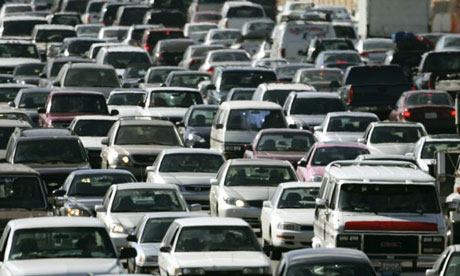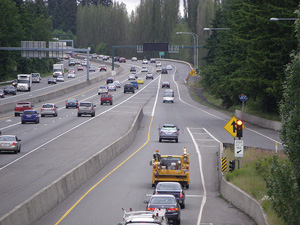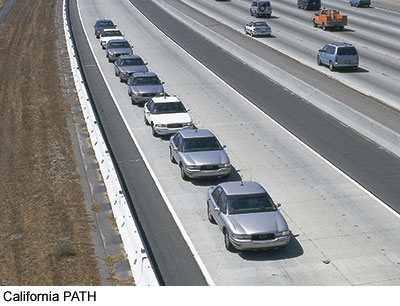Traffic Flow
by Andrew Boyd
Today, point A to point B. The University of Houston's College of Engineering presents this series about the machines that make our civilization run, and the people whose ingenuity created them.
Every weekday, millions of Americans turn on their cars, pull out of their driveways, and begin a journey that will take them to and from work. And as they inch forward in freeway traffic, or sit idly waiting for a light to change, a thought occurs. Can't we build better road systems?

The answer's yes, but it's not always simple. Add more lanes to clear up a bottleneck, and you're likely to create one elsewhere. Shorten the wait at traffic light and you may well wind up clogging the next intersection.
Road systems are complex networks. The engineers who design them are highly trained, and we occasionally catch glimpses of their handiwork. Driving through downtown Houston (or many other large cities) it's easy to see how the lights are coordinated — timed so it's possible to traverse many intersections without stopping. It's color coordination taken to a new level. But it's not as simple as timing the lights on a single stretch of road. Roads cross, feed on and off of freeways, and so on. Without a coordinated design, traffic wouldn't just be a headache; it would grind to a halt.
Electronic media are a simple but effective means of improving traffic flow. Motorists can check out congestion and change their routes if traffic's bad. GPS devices can even make recommendations using calculations that incorporate traffic speeds throughout the road network.
A somewhat more controversial means of managing traffic is through the use of ramp meters — signal lights that control the flow of traffic onto a freeway. Do they work? Are they worth the cost and inconvenience?

That's a question the residents of Minneapolis-Saint Paul asked in the year 2000. Tired of waiting in line to get onto the freeway, they demanded a half-million dollar test be performed. Ramp meters were turned off. Statistics were gathered. And the result? Travel times jumped, speeds plummeted, and accidents went up. Ramp meters proved to be a big win, bolstering the case for their use. The lights were turned back on, but the controversy continues.
Ramp meters work by keeping tightly packed groups of cars from merging onto freeways at the same time. Experimental evidence shows that individual cars merge with flowing traffic much more seamlessly. But ramp meters can cause backups onto city streets. Properly operated, ramp meters make better use of existing road networks. Poorly operated, they create their own set of problems.
Of course, the holy grail of traffic flow is centralized computer-control. Drive onto the freeway, push a button, let go of the wheel, and let a computer program take you to your destination — a computer program that knows the whereabouts of every vehicle in the road network. The technology's on the horizon. Will we use it? Should we use it?

I'm Andy Boyd at the University of Houston, where we're interested in the way inventive minds work.
D. Levinson and L. Zhang. 'Ramp Meters on Trial: Evidence from the Twin Cities Metering Holiday.' Transportation Research Part A, 40 (2006), pp. 810-828.
All pictures are from U.S. government Web sites. The picture of the eight cars traveling together at highway speeds under computer control is from a 1997 demonstration of work performed under the Automated Highway System initiative.
This episode was first aired on December 8, 2011